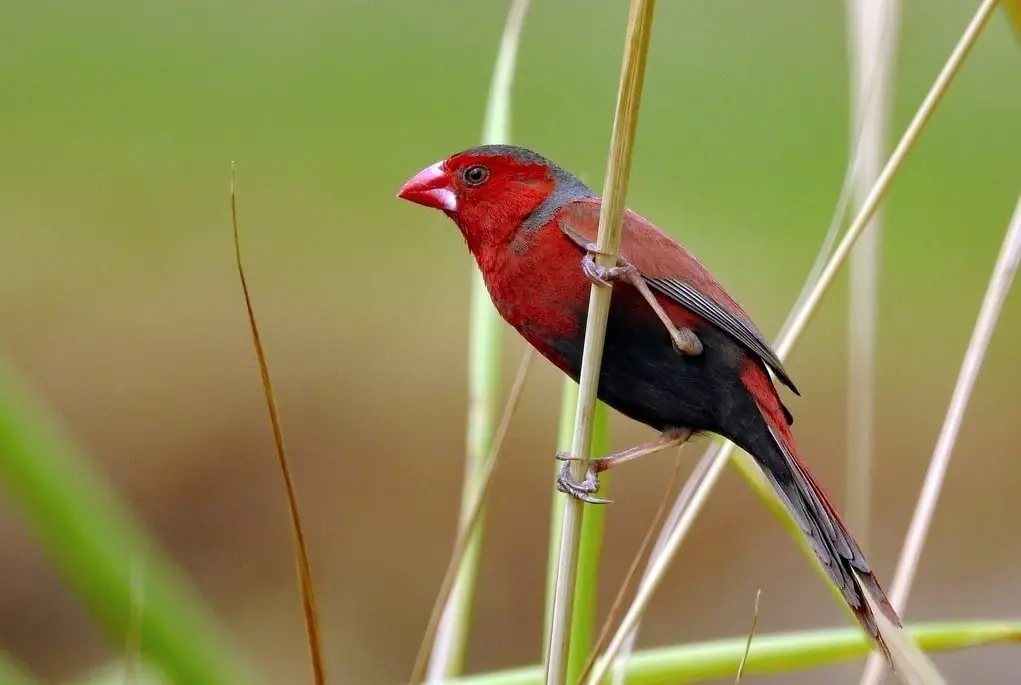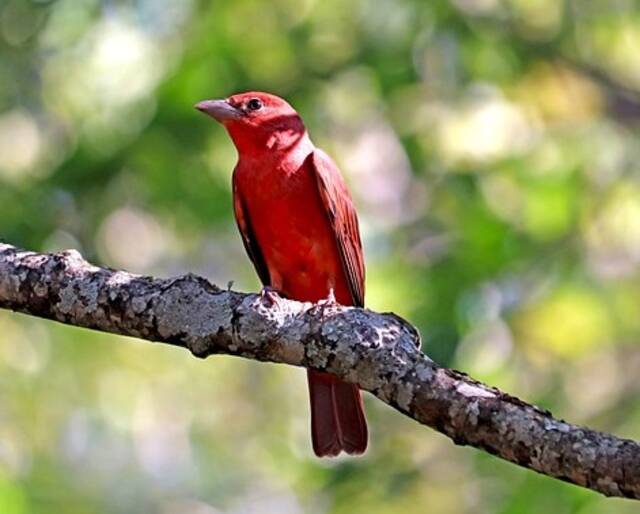Welcome to our avian gallery showcasing nature’s vibrant palette in crimson, scarlet, and vermilion hues. Explore the elegance of 21 stunning birds with striking red heads, each species revealing unique tales of adaptation and survival. From the Scarlet Macaw to the Vermilion Flycatcher, join us on a visual journey celebrating the beauty and diversity of these captivating creatures.
Table of Contents
- 1 Types of Birds with a Red Heads
- 1.1 Downy Woodpecker
- 1.2 Acorn Woodpecker
- 1.3 Red-bellied Woodpecker
- 1.4 Pileated Woodpecker
- 1.5 Red-headed Woodpecker
- 1.6 Red-breasted Sapsucker
- 1.7 House Finch
- 1.8 Vermilion Flycatcher
- 1.9 Western Tanager
- 1.10 Scarlet Tanager
- 1.11 Cassin’s Finch
- 1.12 Red Crossbill
- 1.13 Purple Finch
- 1.14 Pyrrhuloxia
- 1.15 Northern Cardinal
- 1.16 Pine Grosbeak
- 1.17 Brazilian Tanager
- 1.18 Crimson Sunbird
- 1.19 Red-faced Warbler
- 1.20 Red-headed Finch
- 1.21 Summer Tanager
- 2 Author
Types of Birds with a Red Heads
Downy Woodpecker
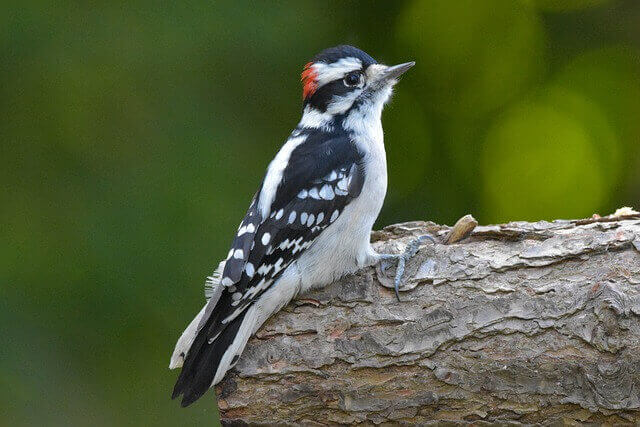
- Length: 5.5-6.7 in (14-17 cm)
- Weight: 0.7-1.0 oz (21-28 g)
- Wingspan: 9.8-11.8 in (25-30 cm)
- Scientific Name: Picoides pubescens
The Downy Woodpecker, a small North American bird found from the Atlantic to the Pacific, is most prevalent in the northeast and southeast United States. The males of this species are distinguished by their striking red heads. They thrive in a variety of habitats, from dense forests to open fields.
Primarily insectivorous, Downy Woodpeckers also consume small fruits and seeds. They commonly forage on the ground or in lower branches, though they occasionally utilize high perches in trees to scan for prey.
Related: How to Attract Downy Woodpeckers to Your Yard? (Easy!)
Acorn Woodpecker
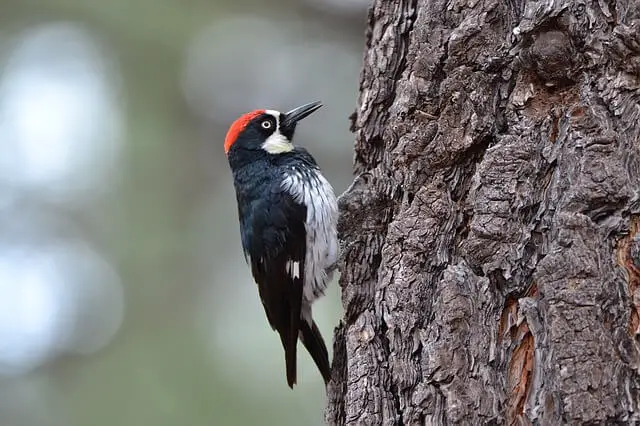
- Length: 7.5-9.1 in (19-23 cm)
- Weight: 2.3-3.2 oz (65-90 g)
- Wingspan: 13.8-16.9 in (35-43 cm)
- Scientific Name: Melanerpes formicivorus
The acorn woodpecker ranges throughout most of North America, from southern Canada to Central Mexico. The bird prefers open woods with plenty of trees and shrubs for perching and for feeding. In the south, they can be found in more humid environments, while in the north they can live in drier areas. The bird’s habitat ranges from coastal forests to high deserts, but most often lives near water – either a stream or a wetland – or in areas with a lot of trees and brush cover.
Acorn woodpeckers are primarily insectivores, eating mainly insects, but also taking a small amount of spiders, tree sap, berries and nuts such as acorns. They will also feed on carrion if it is available. Breeding males will take larger prey items than non-breeding males or females.
Red-bellied Woodpecker
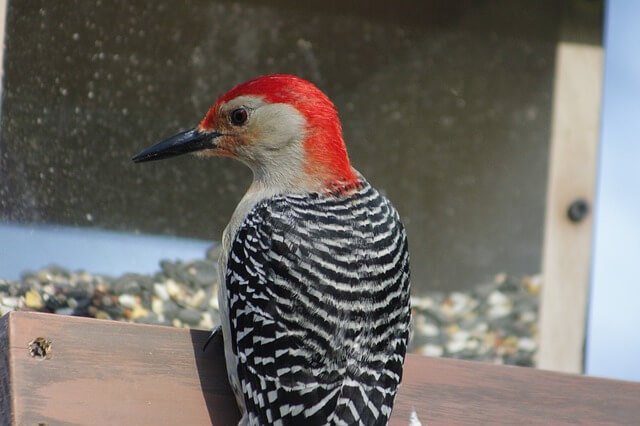
- Length: 9.4 in (24 cm)
- Weight: 2.0-3.2 oz (56-91 g)
- Wingspan: 13.0-16.5 in (33-42 cm)
- Scientific Name: Melanerpes carolinus
The red-bellied woodpecker is a common bird in much of the eastern United States. It ranges from southeastern Canada south to central Mexico, and west to eastern Texas. In the East, this species is most common in the Appalachian Mountains and the New England region. It occupies a variety of habitats including open woodland, shrubby areas and coniferous forests.
Breeding occurs mainly in temperate climates with enough precipitation throughout the year. The red-bellied woodpecker is primarily an insectivore, but will also consume small amounts of fruit, nuts and seeds. This bird nests in tree cavities or on cliff ledges.
Related: How to Attract Red-bellied Woodpeckers to your Yard?
Pileated Woodpecker
- Length: 15.8-19.3 in (40-49 cm)
- Weight: 8.8-12.3 oz (250-350 g)
- Wingspan: 26.0-29.5 in (66-75 cm)
- Scientific Name: Dryocopus pileatus
The Pileated Woodpecker ranges throughout the eastern and central United States, but is most common in the Appalachian Mountains. These woodpeckers live in diverse habitats including deciduous forests, mixed forests, and open fields. They prefer to forage in areas with plenty of trees and openings to provide good views of their surroundings.
These birds are very territorial and will defend their feeding grounds aggressively against other birds and mammals. They are omnivorous and eat insects, fruits, nuts, and seeds. The most common food source for this bird is insects. They will also eat small animals, but this is not as common.
Related: How to Attract Pileated Woodpeckers to your Yard (Fast)
Red-headed Woodpecker
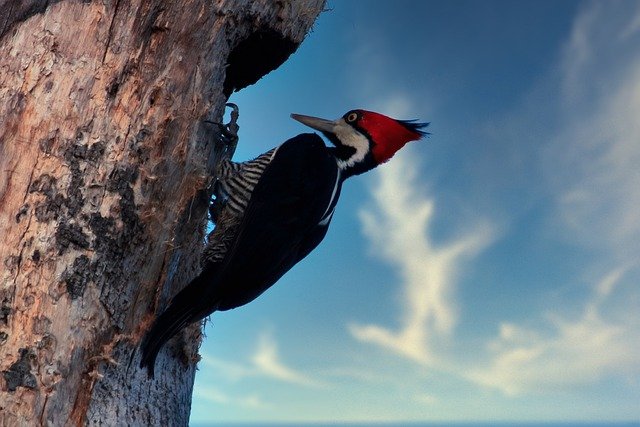
- Length: 7.5-9.1 in (19-23 cm)
- Weight: 2.0-3.2 oz (56-91 g)
- Wingspan: 16.5 in (42 cm)
- Scientific Name: Melanerpes erythrocephalus
The Red-headed Woodpecker is a common bird found throughout North America. They inhabit diverse habitats such as tallgrass prairies, mixed conifer forests, and well-watered areas. The red-headed woodpecker typically eats insects, fruits, nuts, seeds, and occasionally small vertebrates. Their diet varies depending on the region they reside in.
In the north they consume more insects, while in the south they eat more fruit and seeds. Their habitat also affects their diet; in open areas with plenty of trees they prefer to eat insects, but in dense forests they will eat mostly fruit and seeds.
Related: Interesting Red-Headed Woodpecker Facts (Explained)
Red-breasted Sapsucker
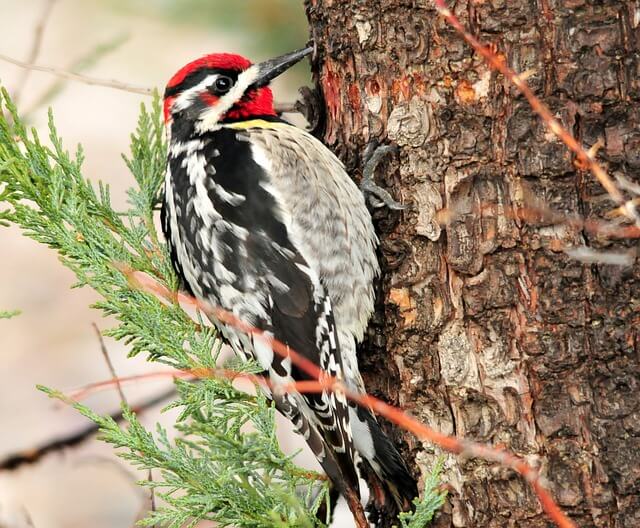
- Length: 7.9-8.7 in (20-22 cm)
- Weight: 1.9-2.2 oz (53.1-63.5 g)
- Wingspan: 14.6-16.0 in (37-40.6 cm)
- Scientific Name: Sphyrapicus ruber
The Red-breasted Sapsucker ranges widely across North America, from the Canadian provinces of Quebec and New Brunswick south to northern Florida and west through Texas and Oklahoma to New Mexico. It is found in subtropical and tropical moist forests, but also frequent in deciduous woodlands.
The sapsucker favors sap from trees such as oaks, maples, sycamores, beech trees, and tulip trees. It also feeds on fruits such as apples, pears, cherries, grapes, figs and other berries. In winter, it will take advantage of bird feeders that are hung close to trees.
Related: 16 Interesting Sapsucker Facts Revealed! (Photos & Info!)
House Finch
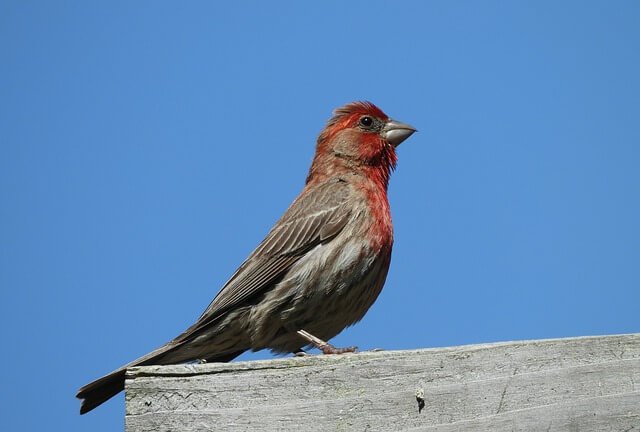
- Length: 5.1-5.5 in (13-14 cm)
- Weight: 0.6-0.9 oz (16-27 g)
- Wingspan: 7.9-9.8 in (20-25 cm)
- Scientific Name: Haemorhous mexicanus
House finches are a small bird that can be found in many parts of the world. This bird is known for its musical ability and for being a common pet. The house finch habitat consists mostly of trees and shrubs with some areas that have dense vegetation. They like to live near water sources, such as streams or ponds.
The house finch diet consists mainly of seeds, buds and fruits. They will also eat insects, but these percentages vary depending on the season. In the summer, they will consume more insects, while in the winter they will consume more seeds and buds.
Related: How to Attract House Finch to your Yard? (Easy & Fast)
Vermilion Flycatcher
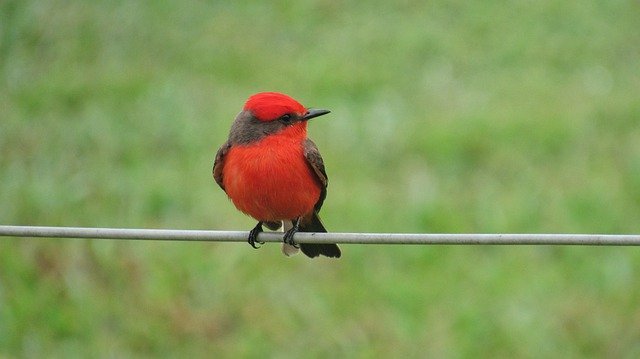
Length: 5.3 in (13.5 cm)
Weight: 0.39-0.49 oz (11.1-14.0 g)
Wingspan: 9.4 to 9.8 in (24-25 cm)
Scientific Name: Pyrocephalus rubinus
The Vermilion Flycatcher ranges across much of the eastern and central United States from Maine south to North Carolina, west to Oklahoma and Texas, and north to Michigan and eastern Canada. It inhabits open woodland habitats with some nearby farmland or marshes. The population has been increasing in recent years due to the increasing availability of open habitats.
Vermilion Flycatchers eat a variety of insects, including beetles, grasshoppers, and caterpillars. They also consume small spiders and other invertebrates.
Western Tanager
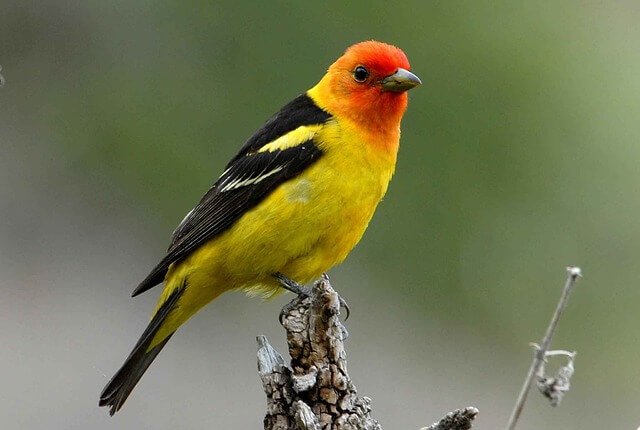
- Length: 6.3-7.5 in (16-19 cm)
- Weight: 0.8-1.3 oz (24-36 g)
- Wingspan: 11.5 in (29 cm)
- Scientific Name: Piranga ludoviciana
The Western Tanager ranges across western North America from southern California to the Yukon Territory. In winter, they migrate to Central America and Mexico. This vibrant bird favors open country with plenty of shrubs and trees for foraging, so it’s common to find them in woodlands, but they are also found near urban areas.
Their diet consists mostly of insects, but they will also eat fruit and berries. They are very active birds and can be seen foraging for food throughout the day.
Related: How to Attract Western Tanager to your Yard
Scarlet Tanager
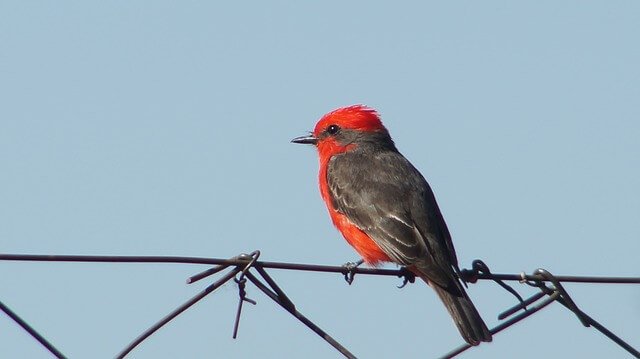
- Length: 6.3-6.7 in (16-17 cm)
- Weight: 0.8-1.3 oz (23-38 g)
- Wingspan: 9.8-11.4 in (25-29 cm)
- Scientific Name: Piranga rubra
Scarlet Tanagers are found throughout North and Central America, but their distribution ranges vary greatly in size. In the USA, they can be found from southern Texas all the way up to northern New England. They can also be found in Mexico, Guatemala and Belize.
Scarlet Tanagers like to live in environments with plenty of open space, as well as trees where they can perch and watch for prey. They primarily eat insects, but will also consume some fruit and berries.
Related: How To Attract Scarlet Tanagers To Your Backyard Fast?
Cassin’s Finch
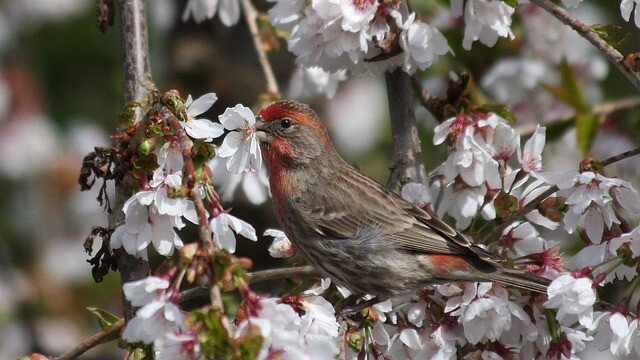
- Length: 6.0-6.3 in (15.2-16.0 cm)
- Weight: 0.8-1.2 oz (24-34 g)
- Wingspan: 9.8-10.6 in (25-27 cm)
- Scientific Name: Haemorhous cassinii
The Cassin’s Finch is a migratory bird that breeds in the northern United States and Canada, and winters in Central America. The cassin’s finch ranges throughout North America, from the north-central U.S. to southern Baja California, but its range is concentrated in the Great Lakes region and on the eastern seaboard of Canada.
The cassin’s Finch is found in many different habitats including open country, woodlands, and suburbs. This bird forages mostly on seeds, buds, and berries, but also consumes insects and other small creatures.
Red Crossbill
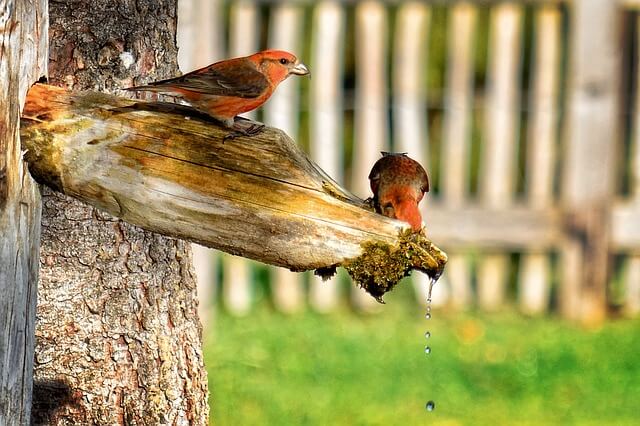
- Length: 7.9 in (20 cm)
- Weight: 1.4-1.9 oz (40-53 g)
- Wingspan: 10.6-11.4 in (27–29 cm)
- Scientific Name: Loxia curvirostra
The Red Crossbill is a small passerine bird found in North America. The red crossbill is a migratory bird which spends the winter in Central and South America, and the summer in North America. The red crossbill has a wide distribution across most of North America. In addition to its wide distribution, the red crossbill is also common throughout its range.
The diet of the red crossbill consists mainly of seeds, buds, and berries. Some insects are also eaten, but these are not a large part of the diet. The main habitat of the red crossbill is open woodland and forested areas.
Purple Finch
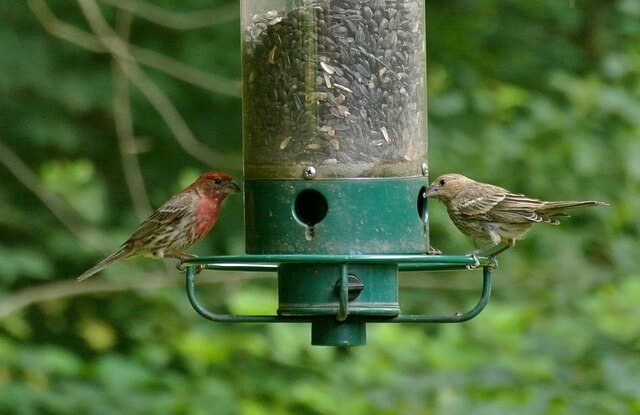
- Length: 4.7-6.3 in (12-16 cm)
- Weight: 0.6-1.1 oz (18-32 g)
- Wingspan: 8.7-10.2 in (22-26 cm)
- Scientific Name: Haemorhous purpureus
Purple finches are native to North America, and can be found in most of the continent. They feed mainly on seeds and buds from trees, weeds, berries and insects, but will also consume small amounts of crickets and spiders. Range states vary in their purple finch populations density; however, they are generally common in regions that have a mixture of open and closed habitats.
In the northern portion of their range, purple finches tend to occupy higher elevations where there is more coniferous growth. Conversely, in the south, they inhabit lower elevations near dense vegetation.
Pyrrhuloxia
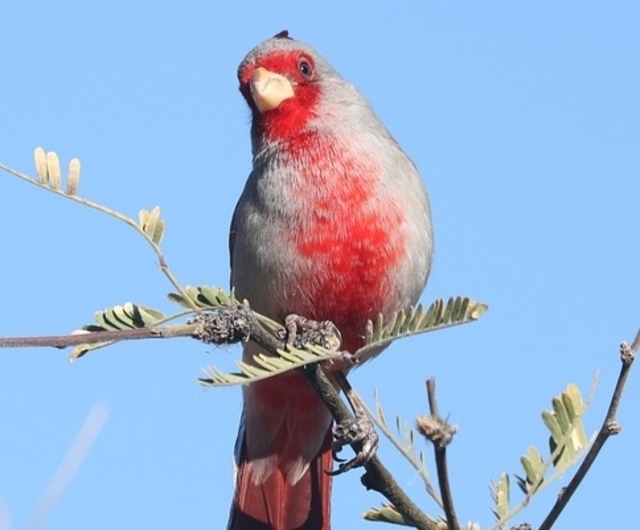
- Length: 8.0-8.3 in (20.3-21.0 cm)
- Weight: 0.7–1.6 oz (19.8–45.4 g)
- Wingspan: 12.0-12.3 in (30.5-31.2 cm)
- Scientific Name: Cardinalis sinuatus
The Pyrrhuloxa desert bird is a small passerine bird found in the southwestern United States and north-central Mexico. The range of this species includes parts of Baja California, Arizona, New Mexico, Texas, and Kansas.
This bird is a resident of these areas and can be found at various elevations. It forages for food on the ground or in low vegetation. The diet consists mostly of seeds, insects, and fruits.
Northern Cardinal
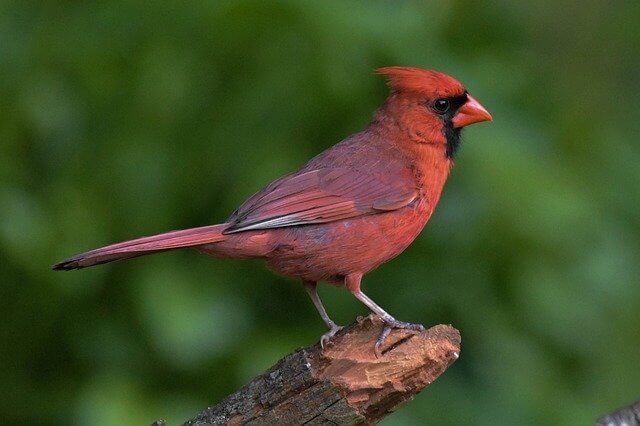
- Length: 8.3-9.1 in (21-23 cm)
- Weight: 1.5-1.7 oz (42-48 g)
- Wingspan: 9.8-12.2 in (25-31 cm)
- Scientific Name: Cardinalis cardinalis
The Northern Cardinal, is a small bird in the family Cardinalidae. It is found in North America and South America. The Northern Cardinal ranges from the eastern Canadian provinces to central Panama, and from southern Arizona and New Mexico to western Texas.
The birds inhabit woodlands, gardens, parks, and other open areas with plenty of trees. They eat insects, spiders, wild fruits (such as blueberries), berries, and weed seeds.
Related:
Pine Grosbeak
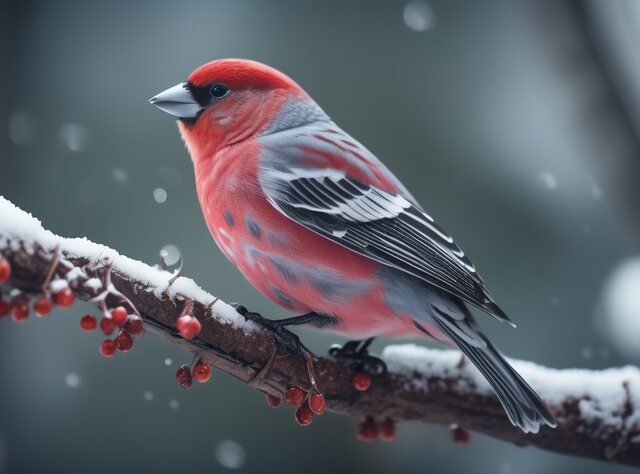
- Length: 8.0-10.0 in (20.3-25.4 cm)
- Weight: 1.7-2.8 oz (48.2-79.4 g)
- Wingspan: 13.0-13.4 in (33-34 cm)
- Scientific Name: Pinicola enucleator
The pine grosbeak is a medium-sized songbird native to the eastern and central United States. The range of this bird includes most of the eastern half of Canada, as well as the southern tier of states in the US. This species is found in a variety of habitats, from heavily forested areas to open fields.
Pine grosbeaks are omnivorous, feeding on seeds, buds, berries, insects and other small prey. They are expert fliers, utilizing their long wings to fly long distances when hunting for food or migrating.
Brazilian Tanager
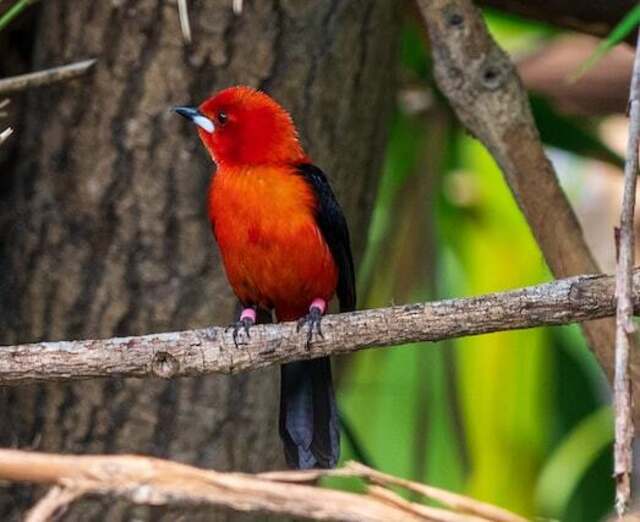
- Length: 7.1-7.3 in (18-18.5 cm)
- Weight: 0.1–1.3 oz (28.0 – 35.5 g)
- Wingspan: 10.0-12.0 in (25.4-30.5 cm)
- Scientific Name: Ramphocelus bresilius
The Brazilian Tanager ranges across Eastern Brazil, Argentina, and North Argentina and Uruguay.. This small, brightly colored bird is found in a wide range of habitats including open woodland, subtropical or tropical moist lowland forests, and mangroves.
It favors fruit-rich trees and arboreal insects, but also consumes seeds and other plant matter. The Brazilian Tanager is a shy bird that spends much of its time in the treetops or among the branches of its chosen habitat.
Crimson Sunbird
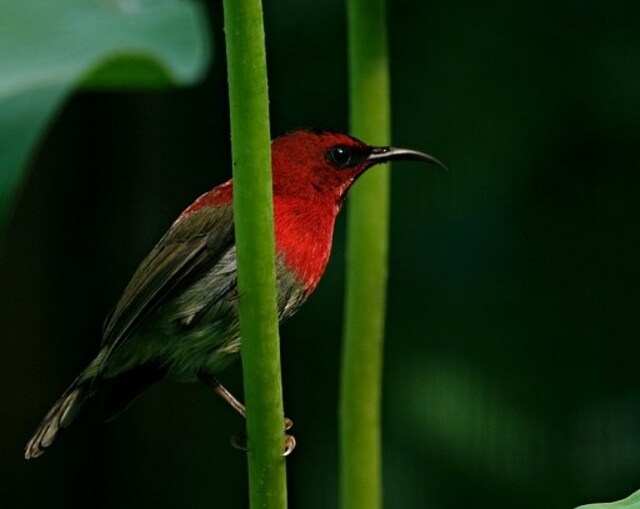
Length: 4.3 in (11 cm)
Weight: 0.16-0.31 oz (4.5-8.7 g)
Wingspan: 4.3 in (10.9 cm)
Scientific Name: Aethopyga siparaja
The Crimson Sunbird ranges from India through Nepal, Bangladesh and Myanmar to Indonesia. It is a resident breeder in its range, but also migrates to south-east Asia. In the Indian Subcontinent this bird is found mainly in dry deciduous forests and some semi-dry thorn forests where it occurs up to an altitude of 1800 meters.
In Bangladesh, this bird inhabits scrub and open woodland, while in Myanmar it prefers lowland evergreen forest. At higher altitudes, they occur in montane rainforest. The Crimson Sunbird is a nectar feeder and mostly feeds on flowers, especially orchids.
Red-faced Warbler
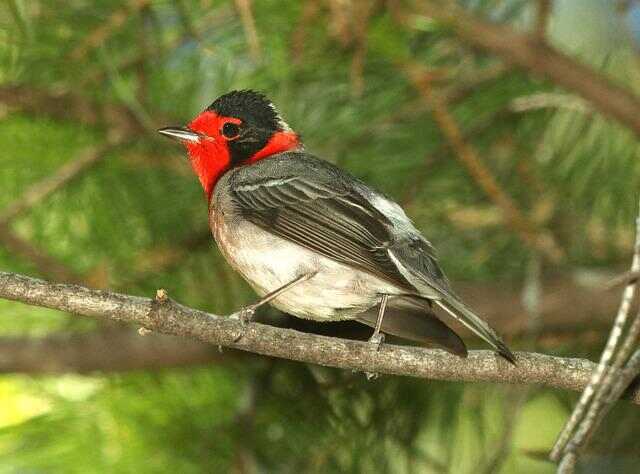
- Length: 5.5 in (14 cm)
- Weight: 0.3-0.4 oz (8-11 g)
- Wingspan: 8.3 in (21 cm)
- Scientific Name: Cardellina rubrifrons
The Red-faced Warbler is a species of warbler found in the Northeastern and North-Central United States and southern Canada. It breeds in the eastern US, southeastern Canada, and central Mexico. The red-faced warbler is a migratory bird that winters in Central America, South America, and Trinidad.
The red-faced warbler’s diet consists mainly of insects. In summer, it eats insects such as beetles, caterpillars, dragonflies, ants, bees, flies, butterflies larvae and spiders. In winter, it eats seeds and juniper berries.
Red-headed Finch
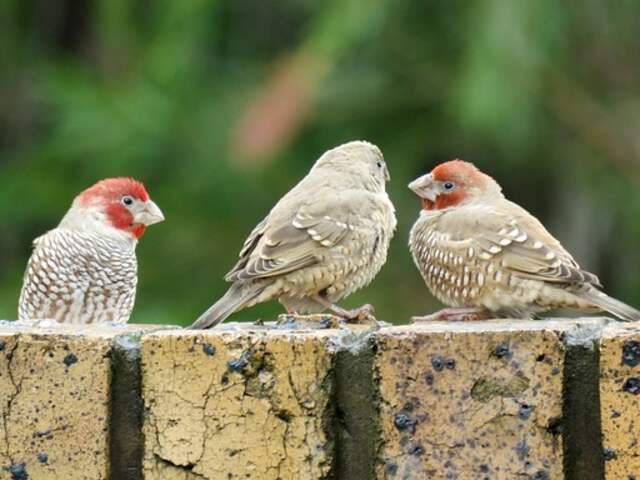
- Length: 6.0-7.0 in (15.2-17.8 cm)
- Weight: 0.6-0.8 oz (19-24 g)
- Wingspan: 8.0-10.0 in (20.3-25.4 cm)
- Scientific Name: Amadina erythrocephala
The Red-headed Finch is a small passerine bird found mainly in Africa. The range of this species extends from Senegal and Gambia in the west, through Chad and Sudan, to Ethiopia and Kenya in the east.
It inhabits a variety of open habitats including dry savanna, subtropical or tropical moist shrubland, and degraded former forest. The red-headed finch is primarily a seed-eater, but it also consumes buds, fruits and insects.
Summer Tanager
- Length: 8.0-8.2 in (20.3-21.0 cm)
- Weight: 0.9-1.1 oz (25.5-31.2 g)
- Wingspan: 11.0-12.0 in (28.0-30.5 cm)
- Scientific Name: Piranga rubra
Summer tanagers are a colorful and varied group of birds found across much of North America and northern Mexico. The eastern summer tanager is found in the eastern United States from Maryland to Florida, the southernmost extent being South Carolina. The southwestern summer tanager is found in Arizona, New Mexico, Texas and parts of Mexico.
The northwestern summer tanager is found in Oregon and Washington. All three species use different habitats, but all have a preference for open woodland with some trees and shrubs mixed in. They eat insects, seeds, fruit, and other small animals.

